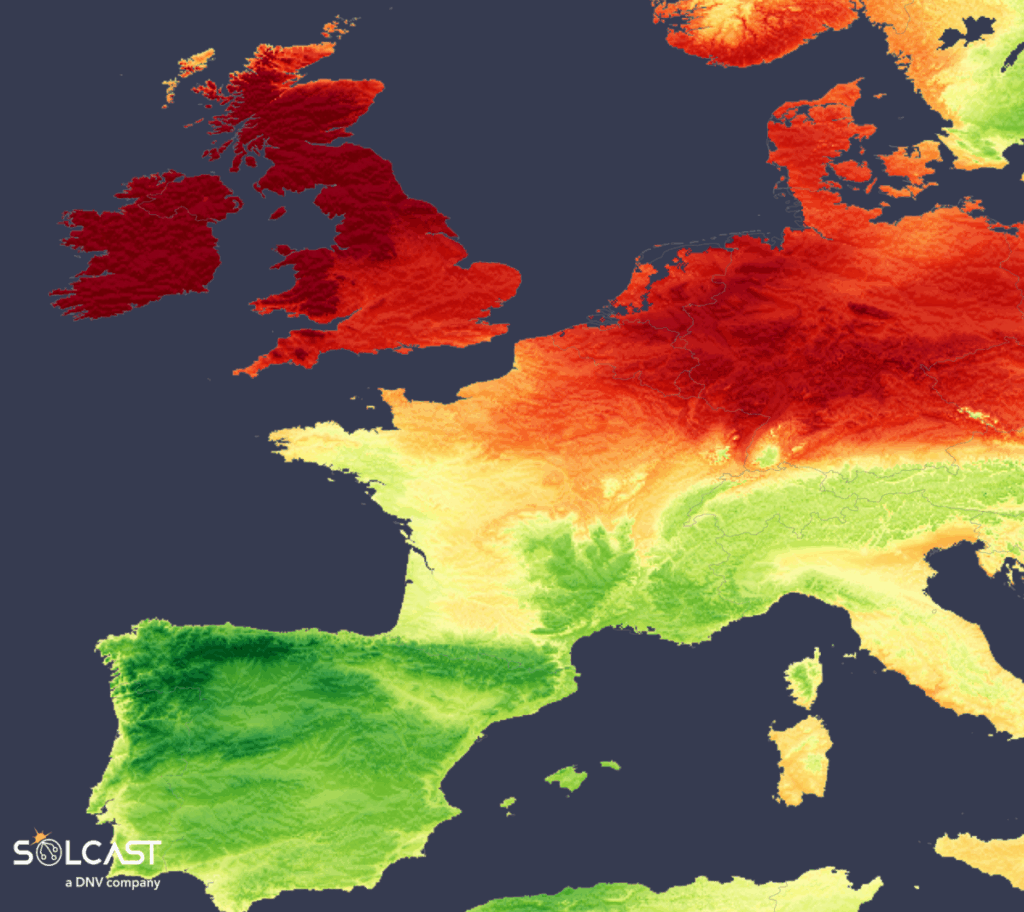In a new weekly update for PV -MagazineSolcast, a DNV company, reports that solar radiation in the British islands reached up to 35% above the standard in the first half of May, while the Netherlands, Belgium and Germany each covered radiation levels about 25% above average.
The British islands have enjoyed an unusually clear start to May, with some areas that see even higher radiation than sites in Spain, according to analysis using the Solcast API. A stubborn high-pressure system over the North Atlantic Ocean has driven clear skies and hot temperatures in north-western Europe, while stormy, moisture-loaded systems have weighed the solar performance on the Iberian peninsula.
During the first half of May, the radiation levels on the British islands reached up to 35% above the standard, so that an exceptional series of sun -friendly weather continued. The Netherlands, Belgium and Germany each registered radiation levels around 25% above average. This eruption of sunshine is linked to a stable high -pressure system above the Atlantic Ocean, which has supplied dry eastern winds from continental Europe and suppresses cloud formation in the region. In London, the temperatures peaked on a monthly record of 29 ° C on 1 May.
The high irradiations that were observed in May on the British islands follow in April due to extreme circumstances and are a continuation of the effects of persistent high pressure. The irradiation in April was considerable above average, with the registration levels of the south of England 20% above the long -term average. The United Kingdom declared it the sunniest April since the records started in 1910. This long -term sunny weather was powered by a persistent ridge of high pressure, which contributed to both increased radiation and unusually warm conditions throughout the region.
While North Europe cherished in the sun, the Iberian peninsula was confronted with a much less favorable pattern for PV generation. Southern Europe experienced cloudy, storm-filled circumstances that significantly reduced the irradiation. In mid-May the radiation levels fell around 20% in much of Spain and Portugal, as well as southern France.
Dublin, usually far behind Madrid in terms of solar generation, has seen more irradiation (94.69 kWh/m²) than the Spanish capital (87.48 kWh/m²) until 15 May. This inversion of typical solar patterns is striking; As you can see in the above, this is an anomaly of recent years, whereby the circumstances in Ireland are approaching ‘normal Spanish’ again. To emphasize the scale of this deviation, Madrid would have registered around 100.25 kWh/m² in an average year, well before the 70.33 kWh/m² of Dublin.
These bad conditions were driven by an improved jet stream that could influence abnormal low pressure systems in southwestern Europe. Combined with moist air masses from the south, this resulted in outbreaks of thunderstorms and heavy rainfall. Some regions in Spain and France also reported large hailstones, causing them to take care of possible damage to solar installations and associated infrastructure.
Dissolved Produces these figures by following clouds and aerosols with a resolution of 1-2 km worldwide, with the help of satellite data and own Ai/ml -algorithms. This data is used to stimulate radiation models, so Solcast is able to calculate the radiation at high resolution, with a typical distortion of less than 2%, and also cloud-tracking predictions. This data is used by more than 350 companies that manage more than 300 GW of solar assets worldwide.
The views and opinions expressed in this article are the author, and do not necessarily reflect it by PV -Magazine.
This content is protected by copyright and may not be reused. If you want to work with us and reuse part of our content, please contact: editors@pv-magazine.com.
Popular content





